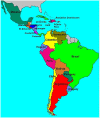Fighting Against Stroke in Latin America: A Joint Effort of Medical Professional Societies and Governments
- PMID: 34659101
- PMCID: PMC8517273
- DOI: 10.3389/fneur.2021.743732
Fighting Against Stroke in Latin America: A Joint Effort of Medical Professional Societies and Governments
Abstract
Introduction: Stroke is one of the leading causes of death in Latin America, a region with countless gaps to be addressed to decrease its burden. In 2018, at the first Latin American Stroke Ministerial Meeting, stroke physician and healthcare manager representatives from 13 countries signed the Declaration of Gramado with the priorities to improve the region, with the commitment to implement all evidence-based strategies for stroke care. The second meeting in March 2020 reviewed the achievements in 2 years and discussed new objectives. This paper will review the 2-year advances and future plans of the Latin American alliance for stroke. Method: In March 2020, a survey based on the Declaration of Gramado items was sent to the neurologists participants of the Stroke Ministerial Meetings. The results were confirmed with representatives of the Ministries of Health and leaders from the countries at the second Latin American Stroke Ministerial Meeting. Results: In 2 years, public stroke awareness initiatives increased from 25 to 75% of countries. All countries have started programs to encourage physical activity, and there has been an increase in the number of countries that implement, at least partially, strategies to identify and treat hypertension, diabetes, and lifestyle risk factors. Programs to identify and treat dyslipidemia and atrial fibrillation still remained poor. The number of stroke centers increased from 322 to 448, all of them providing intravenous thrombolysis, with an increase in countries with stroke units. All countries have mechanical thrombectomy, but mostly restricted to a few private hospitals. Pre-hospital organization remains limited. The utilization of telemedicine has increased but is restricted to a few hospitals and is not widely available throughout the country. Patients have late, if any, access to rehabilitation after hospital discharge. Conclusion: The initiative to collaborate, exchange experiences, and unite societies and governments to improve stroke care in Latin America has yielded good results. Important advances have been made in the region in terms of increasing the number of acute stroke care services, implementing reperfusion treatments and creating programs for the detection and treatment of risk factors. We hope that this approach can reduce inequalities in stroke care in Latin America and serves as a model for other under-resourced environments.
Keywords: Latin America; stroke; stroke centers; stroke system of care; stroke units.
Copyright © 2021 Martins, Lavados, Secchi, Brainin, Ameriso, Gongora-Rivera, Sacks, Cantú-Brito, Alvarez Guzman, Pérez-Romero, Muñoz Collazos, Barboza, Arauz, Abanto Argomedo, Novarro-Escudero, Amorin Costabile, Crosa, Camejo, Mernes, Maldonado, Mora Cuervo, Pontes Neto, Silva, Carbonera, Souza, Sousa, Flores, Melgarejo, Santos Carquin, Hoppe, Carvalho, Mont'Alverne, Amaya, Bayona, Navia González, Duran, Urrutia, Araujo, Feigin and Nogueira.
Conflict of interest statement
The authors declare that the research was conducted in the absence of any commercial or financial relationships that could be construed as a potential conflict of interest.
Figures
References
LinkOut - more resources
Full Text Sources




